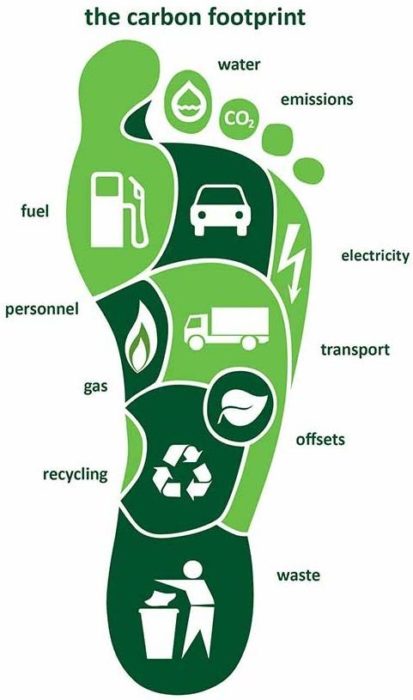Most people know the term ‘carbon footprint’ has something to do with the impact of certain human behaviors on the environment. Many individuals will associate this term with time spent driving a car and the subsequent emissions that result from such actions. Some think of the carbon cap programs that are slowly becoming more commonplace in developed and even some developing nations. All these thoughts are on the right track, but the modern day definition is a bit more detailed. Wikipedia defines a carbon footprint as “the total sets of greenhouse gas emissions caused by an organization, event, product, or individual.”
Kemp, Wright, and Williams put forth a more thorough definition of carbon footprint in the Carbon Management journal:
A measure of the total amount of carbon dioxide (CO2) and methane (CH4) emissions of a defined population, system or activity, considering all relevant sources, sinks and storage within the spatial and temporal boundary of the population, system, or activity of interest. Calculated as carbon dioxide equivalent (CO2e) using the relevant 100-year global warming potential (GWP).
To be sure, this is an excellent definition of carbon footprint. However, you don’t need to devote 100’s of hours to the study of carbon management to make a difference and start reducing your own carbon footprint. By simply consuming less, whether it be fuel, food, or a multitude of other products you can significantly decrease your own individual carbon footprint. Remaining aware about daily actions such as driving, heating & air conditioning, and purchasing food and goods all being part of the picture is a great first step.
One way to frame the idea of a carbon footprint is to think about that old science lesson about Newton’s laws of motion: for every action, there is always an equal and opposite reaction. If a person decides to exert a lot of force on their environment through living a lavish lifestyle, the environment will push back with a force of its own. As a basic example, an individual who chooses to drive a huge SUV, eat lots of meat, and consume a generous number of products and services, will have a relatively big carbon footprint when compared to the average human.
How to Reduce your Carbon Footprint
There are a number of things you can do that aren’t too inconvenient that will help curb your individual emissions.
Personal Vehicle
 By far, the biggest impact on an individual’s carbon footprint is how much they drive and consequently how much fuel they consume. Since most vehicles are still powered by fossil fuels, this fuel consumption significantly increases the sum of their carbon dioxide emissions. Consuming a single gallon of petrol will emit 10.4 kilograms of CO2. That is why walking, biking, or even shared public transportation dramatically reduces individual carbon footprint.
By far, the biggest impact on an individual’s carbon footprint is how much they drive and consequently how much fuel they consume. Since most vehicles are still powered by fossil fuels, this fuel consumption significantly increases the sum of their carbon dioxide emissions. Consuming a single gallon of petrol will emit 10.4 kilograms of CO2. That is why walking, biking, or even shared public transportation dramatically reduces individual carbon footprint.
If you have to drive to work and such, one of the best things you can do is buy a fuel-efficient vehicle. If you do not have the money to purchase an extremely fuel efficient vehicle there are many other things you can do. By following smart driving habits, keeping your vehicle in good shape through ongoing maintenance, and keeping your tires properly inflated you can reduce your CO2 output by thousands of pounds per year.
Travel
Hand-in-hand with driving, is the general approximation of how much time an individual spends traveling. Carpooling, combining trips and errands, biking or walking, purchasing things on the internet, and telecommuting are all excellent behaviors that cut down on travel time and therefore carbon emissions. Sometimes simply thinking things through and asking yourself, “Do I need to take this trip at all?” is a great way to cut down on unnecessary driving trips.
Air travel is another scenario where you want to determine if you really need to make the trip or not. If so, try to fly nonstop instead of taking a connecting flight with multiple stops. While you’re away from home, always make sure all electronics, heating, and anything else that draws energy is turned off. For more green travel tips, check out this list from GreenHotels.com.
Home
In the home, heating and cooling is a big part of the consumption picture. Programmable thermostats, quality windows, weatherstripping/insulation/caulking, and Energy Star approved heating and cooling systems go a long way towards reducing energy use. Energy Star is an exceptional certification to look for when shopping for energy efficient appliances or electronics for your home. The Energy Star program was established by the US Environmental Protection Agency in 1992 as part of the Clean Air Act.
You should always opt for the product with an Energy Star stamp of approval over one without, all other things being equal.
Lighting is another area where significant savings can be had by just swapping out old incandescent bulbs for light emitting diode bulbs (LED) or compact fluorescent light bulbs (CFL). There is a new easy button to eliminate junk mail now too. The production, transportation & delivery, as well as disposal of junk mail really adds up. Plus, you have to spend time sifting through it for the important stuff. A nonprofit 41pounds.org will contact dozens of direct mail companies and get you removed from their lists which cuts down junk mail significantly. At a price of $41 per household for 5 years, this no hassle service is well worth the minimal cost.
Office
Whether at home or at work, the office is a place where a few simple steps go a long way to reducing your carbon footprint. If possible, your computer should always have power management features enabled which will allow your computer and monitor to go to “sleep” and stop sucking up power when not in use. Try to avoid printing things when you can, especially if you can store it on a flash drive or email it as an alternative. Printing double sided will reduce paper use by half. Home office users and people who often work from home should focus on turning off lights and other items in unused rooms. There is no reason to have the whole house lit up when you are only using one room.
Food
What you decide to eat each meal will have an impact on your total carbon footprint. One of the most significant determining dietary factors is how much meat you eat. Average diatary greenhouse gas emissions each day in kilograms of carbon dioxide equivalent holds a pretty substantial difference when comparing high meat eaters to vegans. A study in the Climatic Change journal found high meat-eaters produce the equivalent of 7.19 kilograms of carbon dioxide per day whereas vegans produce 2.89 kilograms.
Remember poultry is less greenhouse intensive than beef. Indeed, you always want to try and eat what you make and buy from the grocery store before it goes bad. However, nobody can perfectly estimate how much food their household will need on a day-to-day basis. Composting is natural process that emits zero emissions and is another big step that will greatly cut down food waste and turns it into something useful.
Recycle
The three R’s: Reduce. Reuse. Recycle. That isn’t too hard to remember now is it? Most of us have picked up this handy little phrase in elementary school and the usefulness of this 3 step cycle it still rings true. Keep in mind that on average, manufacturing a product produces about 4 to 8 pounds of CO2 for every pound of manufactured product. If manufacturers use recycled materials to manufacture their products they reduce how many pounds of CO2 is created. By being an individual who recycles, you are contributing to a positive cycle of life for the materials of our planet.
Buying locally is an additional step you can take outside of recycling that will help scale down your carbon footprint. On average a 5 pound package shipped across the country on a truck will produce 3.5 pounds of CO2 (12 pounds of CO2 if by air). If it is first being shipped across the ocean from a country like China that 5 pound package gets even heavier CO2-wise. Through purchasing locally produced food and products, you side step these added costs of shipping.
Other Helpful Resources:
To calculate an estimate of your own carbon footprint, check out Berkley’s new CoolClimate Calculator tool.
Whether we like it or not, fossil fuels are the bridge to a cleaner energy future. View the CO2 emissions of each type of fossil fuel here.



